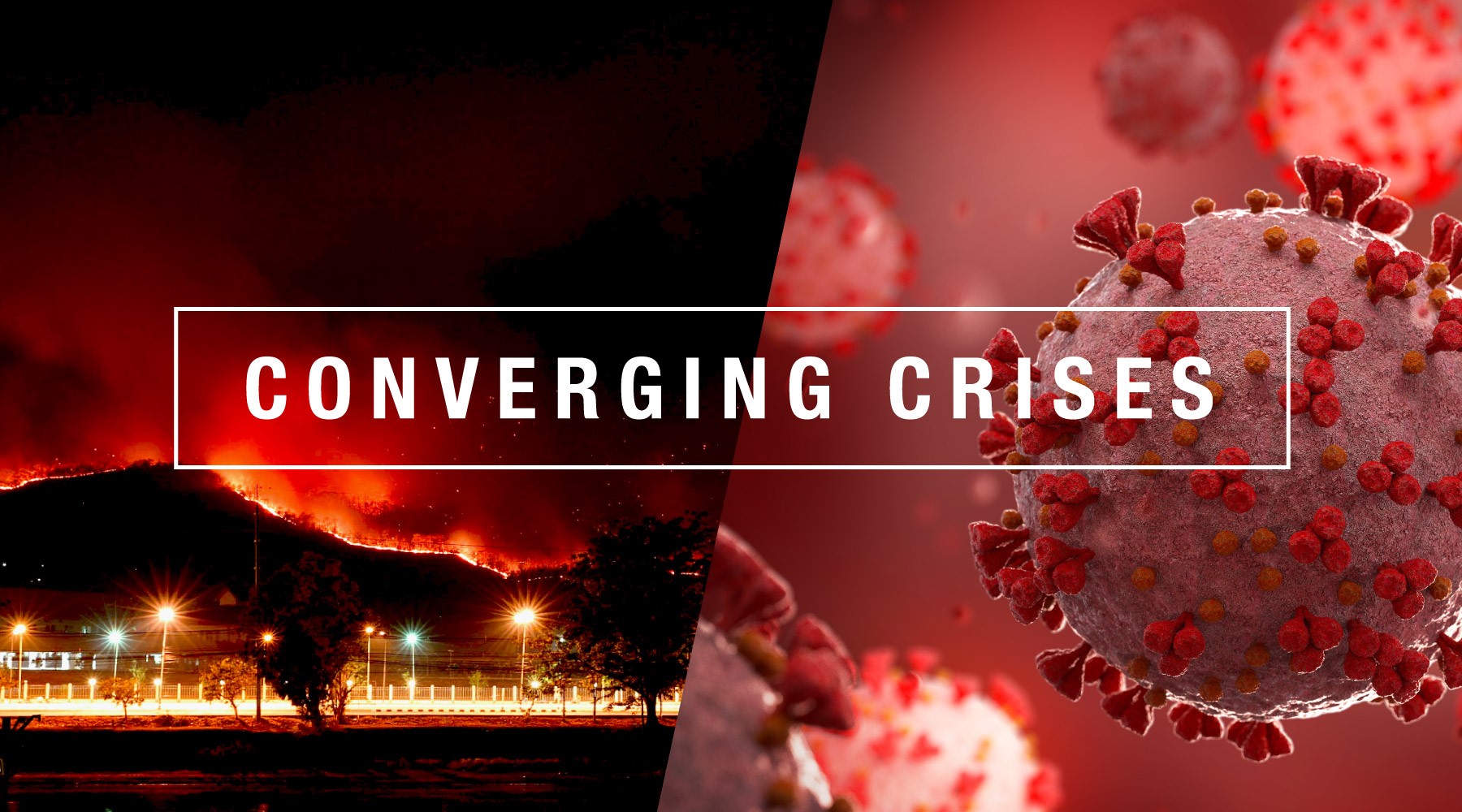So-called ‘once in a lifetime’ events are turning into once a year events, it seems, trending towards the norm rather than the exception.
Take California, for example. In 2018, California had one of the most deadly and destructive wildfire seasons in state history. The following year, planned power outages – known as Public Safety Power Shutoffs (PSPS) – resulted in millions of powerless homes and businesses across the state; some in the dark for days. Now in 2020, COVID-19 has battered the state’s economy – forcing businesses of all kinds to shutter and causing one in nine California workers to file for unemployment.
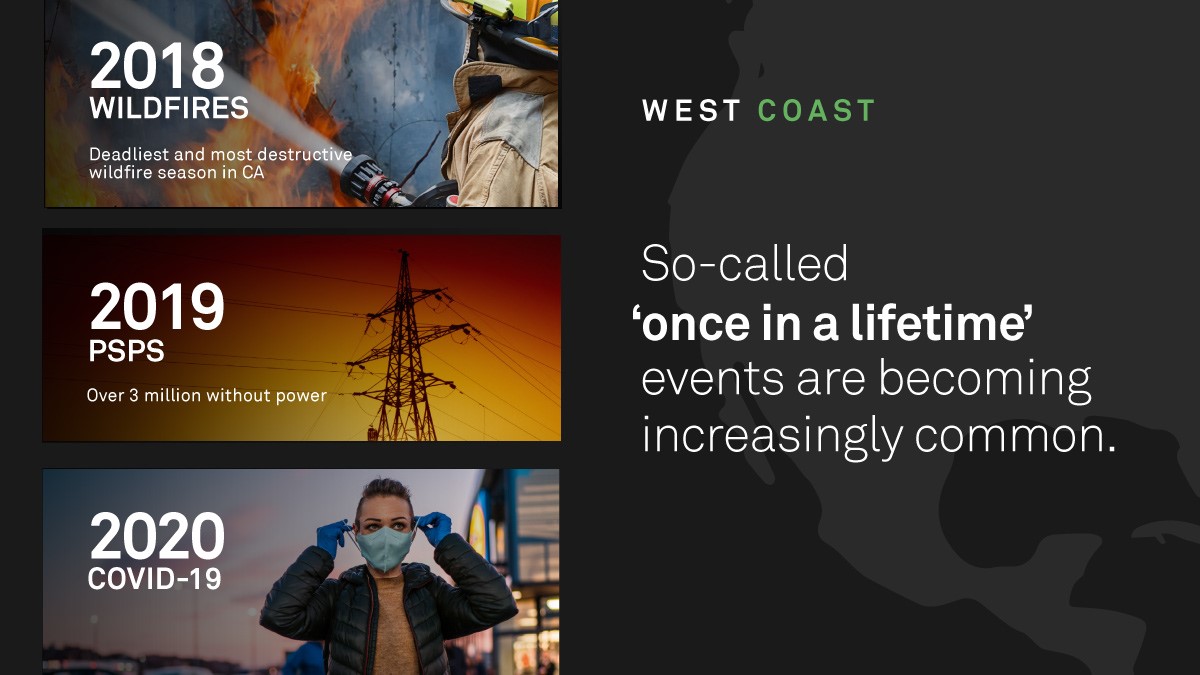
‘Black swan’ events are occurring more frequently than ever, accelerating the need for businesses to demonstrate resiliency to protect against macro disruptions and ensure continuity.
The most unsettling part? More troubling times await.
Fierce wildfire season ahead
Already this year, California has experienced above-average fire activity. There have been 1,130 wildfires so far, about 60 percent more than in the same period last year.
From January to May 10 last year we had 675 wildfires.
From January to May 10 this year we’ve had 1,130 wildfires.
A 60% increase.
As we continue to fight #COVID19 we can’t pull back on priorities that keep us safe. We will continue invest, prepare & fight wildfires across CA.
— Gavin Newsom (@GavinNewsom) May 13, 2020
Unfortunately, the unprecedented situation the state finds itself in due to COVID-19 complicates typical wildfire preparations. With social distancing requirements in place, fire prevention work, such as tree trimming and brush clearing, has progressed slower than usual this year.
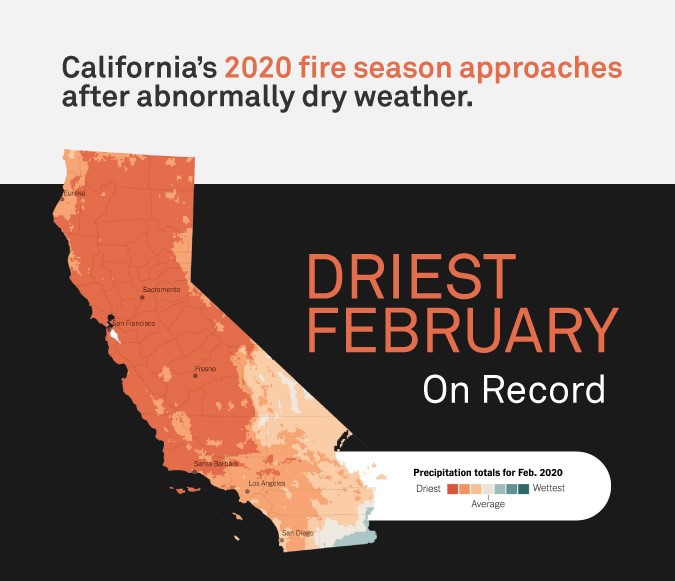
The state’s deadly wildfires over the past couple of years came after traditional rainfall – so you can imagine the outlook for this season then, which is arriving after abnormally dry conditions and drought.
In fact, California had its driest February on record. According to the Washington Post, there wasn’t a single drop of rain in downtown San Francisco during the month of February; something that hasn’t happened since 1864.
According to California’s Department of Water Resources, “March and April storms brought needed snow to the Sierras….however those gains were not nearly enough to offset a very dry January and February.”
And, just like it has slowed wildfire preparedness, COVID-19 is also expected to slow response this upcoming fire season. Power-line crews, who typically work in close proximity, must follow CDC guidelines while fixing downed wires. This may impact repair efforts and the time it takes to restore power.
To make an already difficult situation much worse, businesses and communities across the state must be prepared to lose power – and remain in the dark – for days at a time.
Prevent power disruptions: Get ready for 2020’s wildfire season
Since the state’s deadliest wildfire was linked to aging grid infrastructure, California’s major utilities began implementing preemptive Public Safety Power Shutoffs (PSPSs) – cutting power to entire regions when fire risk appears high.
Rapid Microgrids support disaster preparedness
The unprecedented challenges California is facing in 2020 might make it the year that microgrids rise to the top.
Since microgrids generate power onsite right where the electricity is consumed, they avoid the vulnerabilities (and costs) of the conventional transmission and distribution system. They also avoid the associated dangers of running aging power lines through high fire risk areas.
A truly 21st century technology, microgrids flip the traditional energy paradigm – they provide primary power onsite and treat the grid as backup. Importantly, microgrids are a proven technology; one that’s saved businesses from hundreds of thousands of dollars in costs associated with downtime and one that’s kept critical community facilities like supermarkets and telecommunications operators powered through severe storms.
RELATED: Bloom kept customers up and running in 2019, despite rising grid failures

Bloom is a leader in the microgrid space with more than 80 projects deployed around the globe. In response to these unprecedented challenges, we’ve adapted our microgrid solution to offer something new – something that enables business continuity in times of emergencies. It’s called a Rapid Microgrid, and it can be deployed in a matter of days to serve businesses with the clean, reliable power they need.
Last month, Bloom deployed two of these projects in California to support field hospitals expected to treat COVID-19 patient overflow.
RELATED: Powering field hospitals to save lives during the COVID-19 outbreak
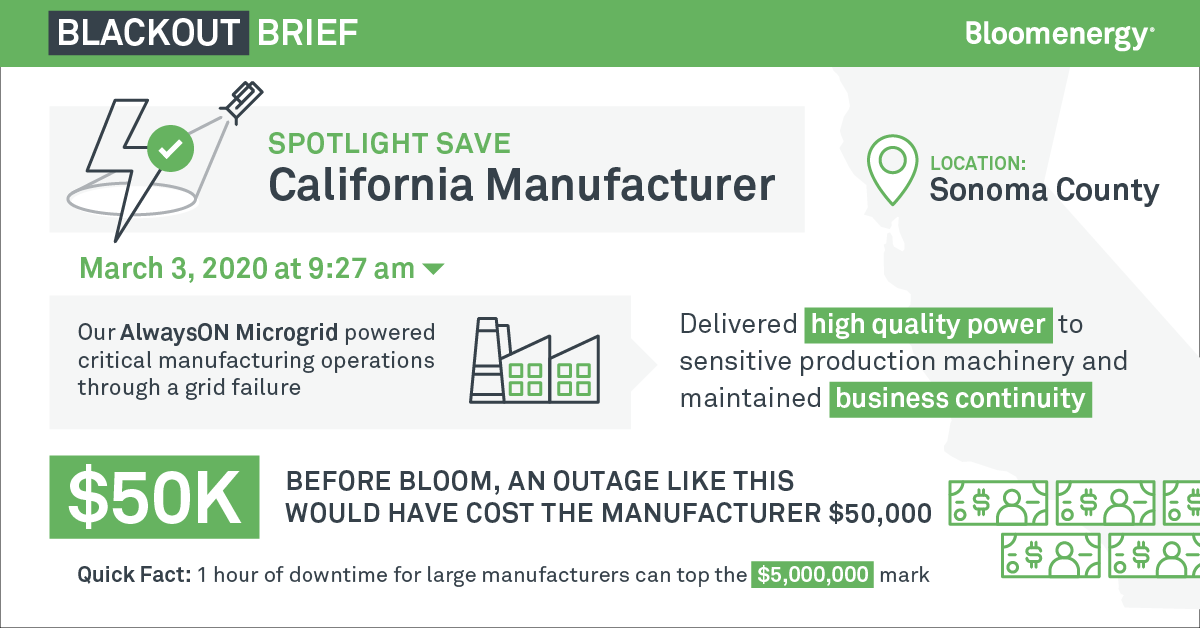
In March, Bloom’s microgrid helped keep a California manufacturer up and running through a grid outage, ensuring the facility’s critical machinery continued operating without a hitch. Before Bloom, an outage like this would have cost our customer $50,000.
California’s new power paradigm
The power grid in California was built more than a century ago, with only fragments of its infrastructure being upgraded along the way. The average age of transmission towers in the state is 68 years old.
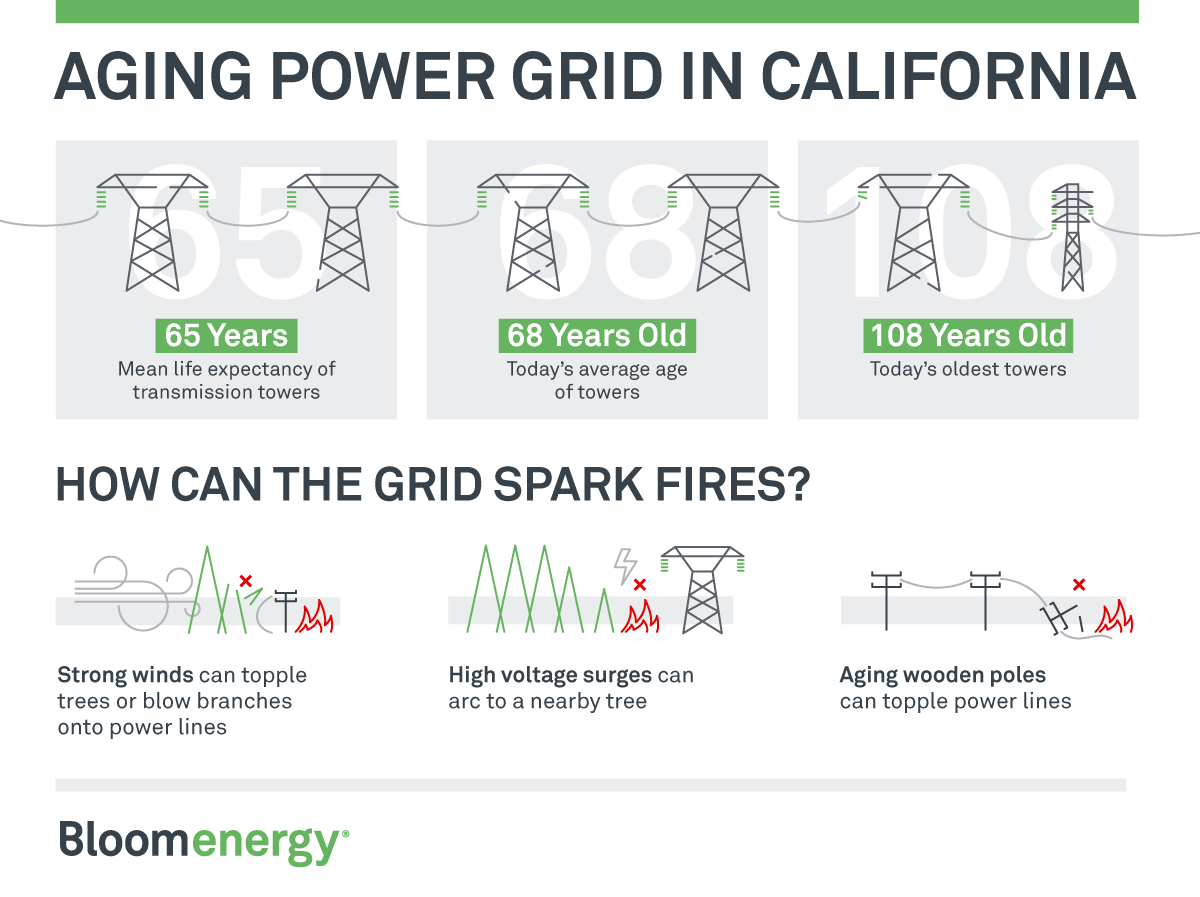
This outdated grid infrastructure is what increases the risk of sparking wildfires during dry, windy conditions, triggering the need for the state’s PSPS program.
Over the past two wildfire seasons alone, there were more than 2,300 of these PSPS events, impacting more than 2.3 million customers. And, don’t forget, 2.3 million customers actually means about 5.7 million people (under the standard assumption of 2.5 people on average per utility meter).
RELATED: California’s Largest Planned Power Outage (So Far): What Happened?
Last year, when three of the largest planned blackouts in state history swept California within the span of a couple months, as many as 100,000 businesses in Northern California lost electricity – forced to scramble to serve clients, keep their doors open, and reduce damage to their bottom lines.
Any business that receives electric service from Pacific Gas and Electric (PG&E), San Diego Gas & Electric (SDG&E), or Southern California Edison (SCE) must be prepared for a possible Public Safety Power Shutoff that could keep the lights out for days at a time.
These three utilities have an aggregate service area that covers nearly 125,000 square miles – the equivalent of 75 percent of California’s total land mass. There’s a strong chance your business or community is in the impact zone.
Check out our California Power Outage Map to see when and where blackouts have occurred
Unfortunately, we can expect more PSPS events not only this fire season, but also beyond – “Wildfire blackouts could be California’s new normal for the next 10 to 30 years, or even longer,” senate energy committee chair Lisa Murkowski voiced in a hearing on utility and fire safety last December.
RELATED: California communities brace for more blackouts
An evolving approach to power
With converging crises ahead, it’s more pressing than ever for California to evolve its approach to power. For decades, the state has been regarded as a leader in technology and innovation – now’s the time to prove it.
In times of crisis, businesses like supermarkets, big box retailers, telecom operators, manufacturers, healthcare facilities, and data centers can’t afford to be without power. And, while it’s unknown how the next few months will play out, we’re determined to bring solutions like the Rapid Microgrid to businesses and communities throughout California and beyond – so that when challenging times do undoubtedly arise, we can weather the storm, together.
#TogetherWeCan #BeTheSolution
Defend your business or community against power outages
 Asim Hussain oversees commercial strategy and customer experience at Bloom Energy. In his 10 years at the company, Asim has held various strategic marketing positions. He has extensive knowledge in clean tech energy, distributed generation, smart grid, and energy economics.
Asim Hussain oversees commercial strategy and customer experience at Bloom Energy. In his 10 years at the company, Asim has held various strategic marketing positions. He has extensive knowledge in clean tech energy, distributed generation, smart grid, and energy economics.

